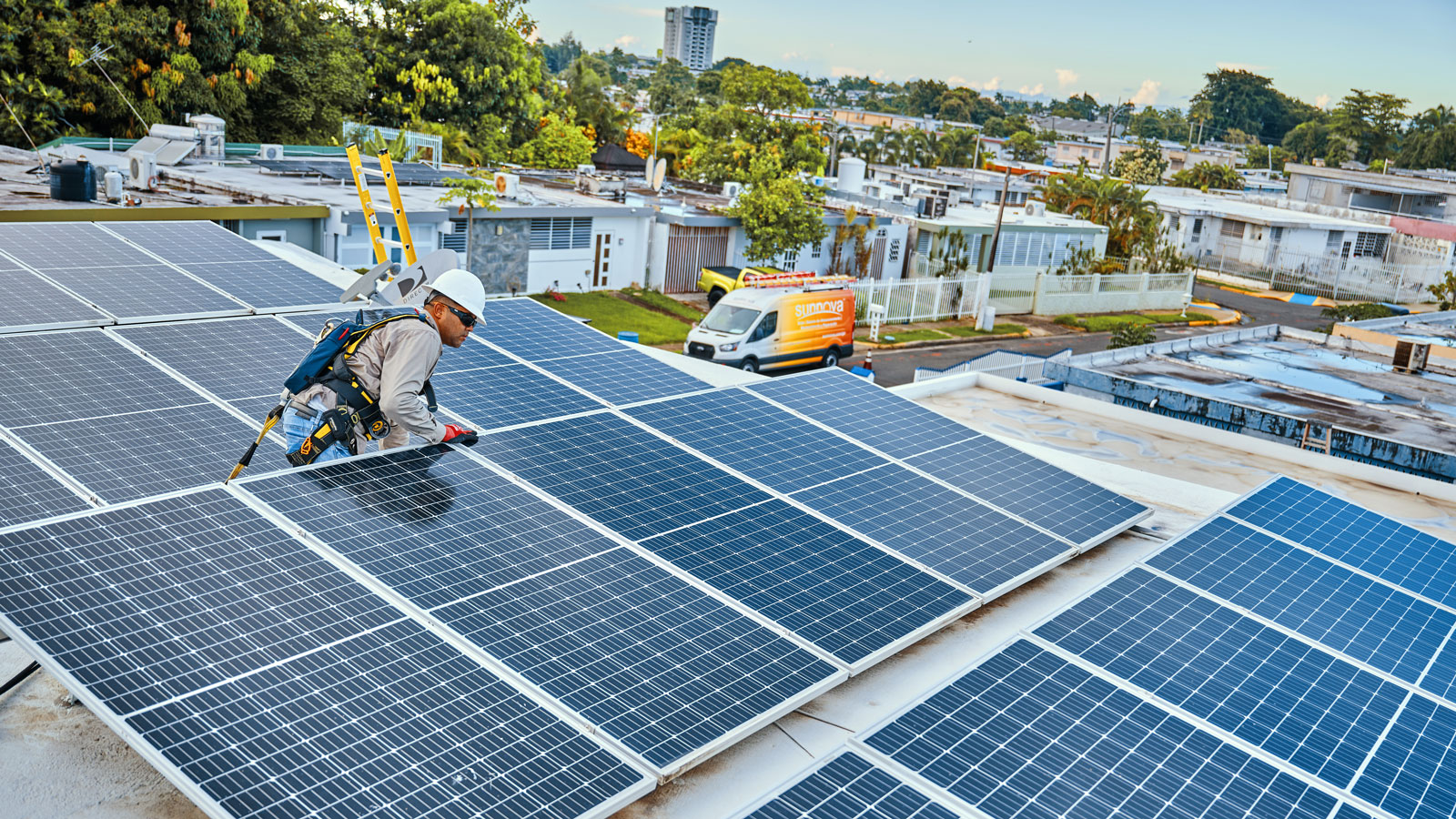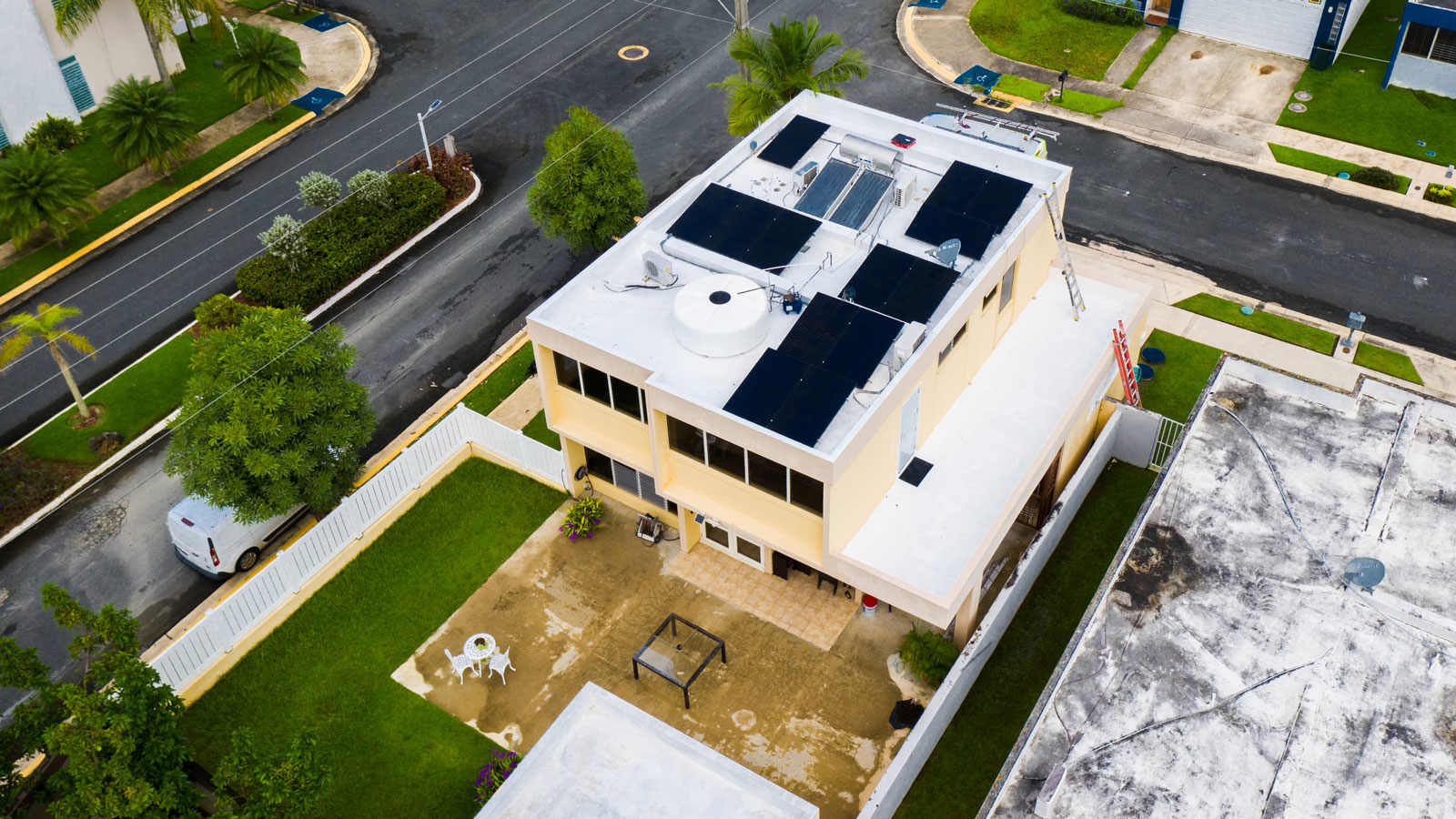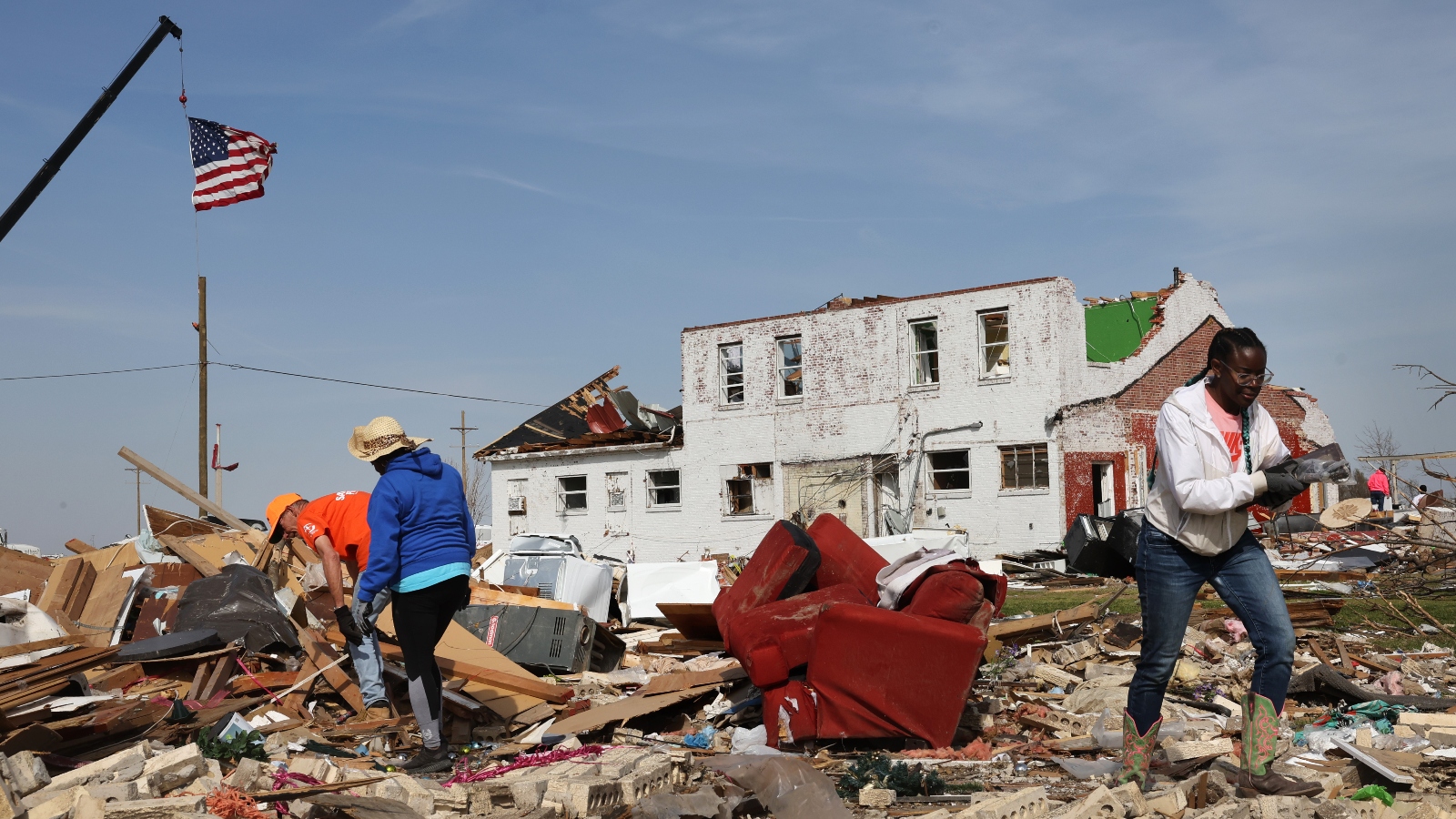The coastal communities of Guayama and Salinas in southern Puerto Rico feature acres of vibrant green farmland, and a rich, biodiverse estuary, the protected Jobos Bay, which stretches between the neighboring townships. But this would-be tropical paradise is also the home of both a 52-year-old oil-fired power plant and a 22-year-old coal-fired power plant, which local residents say contaminate their drinking water and air, and harm people’s health.
“It’s a classic sacrifice zone,” said Ruth Santiago, a lawyer and community activist who has fought against environmental injustice in Puerto Rico for more than 20 years. “A friend calls this ‘the beautiful place with serious problems.’”
Local residents envision a cleaner future as these fossil fuel plants are scheduled to retire within the next several years. They see rooftop solar as the best alternative as the island transitions to renewable energy.
In November 2023, the federal government allocated $440 million in funding for rooftop solar energy in Puerto Rico, part of a billion dollar energy investment in the island. Officials, in recent years, have acknowledged that the region has suffered as the home of polluting power plants.
After a 2022 visit to Salinas and Guayama, Environmental Protection Agency Administrator Michael Regan announced a plan to spend $100,000 to improve monitoring of the air and water pollution from the coal-fired power plant, which is owned by Virginia-based Applied Energy Services Corporation, or AES.
“For too long, communities in Puerto Rico have suffered untold inequities—from challenges with access to clean drinking water to fragile infrastructure that cannot withstand the increase and intensity of storms brought on by climate change,” Regan said in a press release.
The EPA examined a drinking water sample in May 2023 from groundwater near the power plants that supplies drinking water to the region and found that metal levels did not exceed federal criteria. EPA public information officer Carlos Vega said more samples will be analyzed and the EPA will continue to inform the community. No timeline for the additional testing has been established.
For decades, most of Puerto Rico’s electricity has been generated in the southern part of the island. The Puerto Rico Electric Power Authority uses over 30,000 miles of distribution lines to send energy generated in the south to more urban areas, primarily in the north, like San Juan.
Coastal power plants in the south have posed health risks for community members, Santiago said; according to a 2022 report from the environmental law nonprofit Earthjustice, the AES plant produces 800 tons of coal ash waste per day that contaminates the air and nearby waters. Many low-income residents in the south struggle to pay electricity bills that are more than 30 percent higher than in the U.S. as a whole. Nearly half of Guayama’s residents were below the poverty line in 2022.
AES did not respond to multiple email requests for comment. AES Puerto Rico said that their plants are in compliance with regulations in a 2020 press release.

Esther Frances/Medill News Service
An EPA inspection in 2021 revealed the coal facility was not in compliance with the Clean Water Act for releasing polluted stormwater without a permit. In 2022, the EPA found the coal plant exceeded legal emission limits for pollutants like carbon monoxide and mercury, according to an Earthjustice analysis. The EPA issued several other violations for the coal plant dating back to 2019, citing it for inadequate disposal of coal ash and endangering residents, according to the Environmental Integrity Project, an environmental watchdog group.
“People know that it’s a terrible impact, but it’s not easy to move to find somewhere else to live,” Santiago said.
Many local residents cannot move because average home prices have increased across the island since Hurricane Maria hit in 2017, according to activists and researchers in Puerto Rico.
The coal plant is scheduled to retire in 2027, when a 25-year contract expires between AES and the Puerto Rico Electric Power Authority. To replace coal, AES has turned to utility-scale solar power.
AES Puerto Rico began construction for the 135-acre Ilumina Solar PV Park in Guayama in 2011. AES Puerto Rico’s coal plant, solar farm and some smaller projects together supplied up to 25 percent of Puerto Rico’s electricity.
A few solar farms have already been built on the South Coast, and in February 2022, the Puerto Rican Energy Bureau approved 18 new utility-scale solar panel projects across the island. Critics say the solar farms are using dwindling agricultural land, and a group of environmental and public health organizations including Earthjustice and the Sierra Club Puerto Rico filed a lawsuit in August 2023 to stop the government of Puerto Rico from allowing the solar farms to be built on ecologically important land.
A 2019 law mandated that the Puerto Rico Electric Power Authority reduce the use of fossil fuels for electrical generation on the island and generate 100 percent renewable energy by 2050. In addition, the Puerto Rico Electric Power Authority issued an Integrated Resource Plan in 2020 that includes a plan to retire the Aguirre Power Complex oil-fired plant by 2030.
Instead of large solar farms, many local organizations in Puerto Rico see a better solution for their region’s electricity production—rooftop solar panels. They prefer this kind of solar energy for communities because unlike large solar facilities, rooftop solar installations do not use up farmland, which in Puerto Rico decreased by 37.5 percent between 2012 and 2018, according to the Census of Agriculture.
In February, the Department of Energy released results of its study of Puerto Rican renewable energy, named PR100. The study reported the huge potential for rooftop solar in Puerto Rico—up to 6,100 MW by 2050 under the most aggressive scenario—but said utility-scale renewable energy would still be needed.
The study also noted the challenges in deploying rooftop solar, including unstable roofs and lack of property titles. But Puerto Rico has a long way to go to reach the 2050 green energy goal; as of 2022, only 6 percent of electricity generated in Puerto Rico was renewable.
Ruth Santiago’s son Jose and other electricians helped install rooftop solar panels in Salinas neighborhoods through Coquí Solar, a community-based organization working to help low-income and vulnerable residents access solar energy.
The solar kits from Coquí Solar provided homes with solar panels and batteries, which could provide electricity during a blackout. Rooftop solar arrays often cannot meet a home’s entire electricity demand, but the battery storage the solar array generates can run crucial things like refrigerators, lights and medical equipment in case of an electrical blackout, while also reducing a household’s energy bills significantly.
The kits cost about $7,000, which Ruth Santiago said Coquí Solar purchased using grants from various Puerto Rico-based organizations and foundations. Coquí Solar, working with other organizations in the area, also installed the equipment in the homes of vulnerable community members for free. Jose Santiago said the elderly and people living with chronic illnesses and disabilities in the area suffer during blackouts, which are frequent on the island.
“Every year, the power leaves for five, six days,” Jose Santiago said. “Sometimes more, sometimes several times, and you don’t want to see the old people in the line at the gas station trying to get ice to put in their fridge. So, [rooftop solar energy] helps them.”
After Hurricane Maria caused structural damages to the island’s electrical infrastructure in 2017, the Puerto Rico Electric Power Authority reported that all of their electric consumers, over 1.5 million customers, were without power. Some Puerto Rico residents spent close to 11 months without power, according to climate change and development specialist Ramón Bueno.
“That just sounds like a number, but all we have to think about is how do we deal with losing power for two, three days? That’s radical,” Bueno said. “So, two, three months is very radical. And five times that is even more.”
Ruth Santiago said Coquí Solar’s rooftop solar installments have empowered the community by giving residents “agency” over their electricity generation. The desire for electricity independence had grown in Puerto Rico after recent destructive hurricanes and other impacts of climate change.
Organizations like Coquí Solar have spent years working toward decentralizing solar energy across the island, and Bueno said many are strong and independent.
“They’re pretty articulate framers of an alternative way to move forward with energy systems,” Bueno said.
Ruth Santiago worried that the retirement dates of the coal and oil plants could be delayed or that a new infrastructure would depend heavily on utility scale solar that would rely on a centralized grid and expose communities to blackouts during and after storms. She hoped that concerns about the community’s health and environment would be enough to force the plants to close on schedule and that rooftop solar would be prioritized over large-scale solar.
“We need to really go beyond resilience, we need to go toward energy security and sovereignty, and that’s what we’re trying to do, at least create and do these pilot projects, these community-based examples of what that transformation would look like,” Ruth Santiago said. “If we don’t do it now, then when?”
This story was originally published by Grist with the headline As fossil fuel plants face retirement, a Puerto Rico community pushes for rooftop solar on May 18, 2024.




